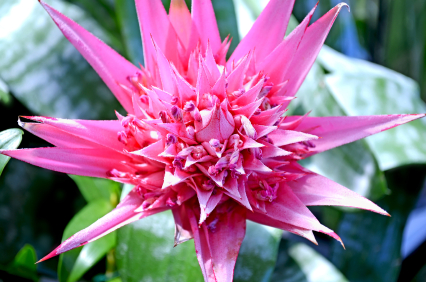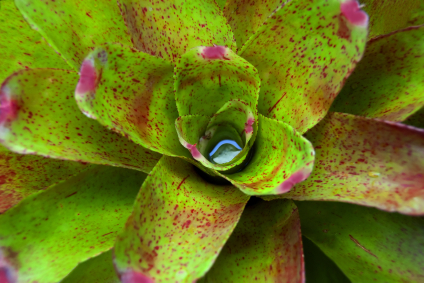Popular Bromeliad Cultivars
Author: Celeste BoothNo Comments
Bromeliads are classified in three families: Bromelioideae, Pitcairnioideae and Tillandsioideae. Within each of these families, there are numerous genus and species. Each bromeliad is uniquely adapted to its growing environment, whether it is humid or arid, bright or shaded, forest or desert. Throughout history, bromeliads have been discovered, studied and cultivated. With the exception of commercial pineapple growers, bromeliad cultivation is for hobby, decoration or landscape purposes. Because bromeliads are grown in new climates with a specific purpose such as having beautiful foliage or providing decorative landscaping in shady spaces, horticulturists have been working to develop varieties whose natural adaptations are exaggerated or more predictable to fit the needs and desires of human growers.
The Rules

-A beautiful pink Aechmea
Because there are so many different varieties of crosses and cultivars it is important to understand the differences between them. To understand the various bromeliads you must understand how naming the new human-crafted plants works. There is a worldwide regulation for plants that have been created through cultivation called the International Code of Nomenclature of Cultivated Plants or ICNCP. The regulation is in place so that naming cultivated plants and groups of plants remains uniform throughout the world. This regulation does not trademark names. It simply maintains that registered names follow the appropriate form for cultivar, group and grex while also making sure that each name is unique to that cultivated plant. Regulating the naming process prevents confusion over the identification of various cultivars.
Cultivar
A cultivar is a plant that has been grown for a specific characteristic, whether it is foliage color or disease resistance. When propagated, a cultivar will produce the specific characteristic every time. A cultivar is denoted by an epithet in single quotes that follows the scientific genus and species name. The genus and species name is in italics while the cultivar name is not. In some cases only the genus name may be used first. One example of a cultivar name is Aechmea ‘Foster’s Favorite.’
Groups
Groups refer to a grouping of plants that have a similar characteristic. For example, variegated foliage or red flowers would be groups. A plant can belong to more than one group. A group name follows the genus and species name and is not enclosed in quotes or italicized. It also includes the word “Group”.
Grex
A grex is a group of plants, usually hybrids, that will not necessarily have exactly the same characteristics every time they are propagated. Because the plants are cultivated sexually through two different species there is no way to guarantee that the plants will even look similar let alone have the desired characteristic. Because a grex is so variable The Bromeliad Society International no longer registers them.
Registration
A cultivar can be registered once a specimen with unique characteristics is chosen from the grex and several cycles of asexual propagation through “pupping” has taken place. If the pups consistently show the unique characteristics and can be identified as unique from any other currently registered bromeliad they may then be registered as a cultivar.
Trademark
Trademark hybrids legally allow only the grower that originally cultivated the plant to propagate and sell the plant for a specific period of time or they may regulate who is allowed to grow and distribute the plant. Trade names and popular names may be different than registered scientific names. What you buy in a nursery may not have a name that looks exactly like the names described above. However, a knowledgable grower should be able to tell you the cultivar name and what characteristics the plant will have.
Bigeneric
Most hybrids are between species within the same genera. In some cases growers are able to cross different genera as well. Most of these crosses are not likely to happen in nature, but experienced horticulturists have discovered techniques for propagating these unique hybrids. These hybrids, called bigenerics, are indicated with an x in front of the new genera name to indicate that these genera do not occur in nature. Geoff Lawn, in an article posted by the Florida Council of Bromeliad Societies, states that there are 279 bigenerics, within 38 of the 40 genera of bromeliads. Lawn also discusses that growers have not been able to cultivate bigeneric across the three sub-families of Bromeliads. xCryptbergia a cross between Cryptanthus and Bilbergia genera is a popular bigeneric. xGuzvriesea, hybrids between Guzmania and Vriesea also create spectacular plants with beautiful foliage and showy flower spikes.
Popular Hybrids
There are an incredible number of hybrid bromeliads available from bromeliad growers. The following are just a few of the popular hybrids available:

-The speckles of a Neoregelia
- Aechmea ‘Echidna’ has a beautiful dusty green foliage with silver banding. The inflorescence is a beautiful light gray pink color. This is a great cultivar for beginner bromeliad growers.
- Neoregelia ‘Fireball’ is a small plant that is 4-6 inches tall and forms large clusters. It has glossy deep red-purple foliage. It can survive in USDA zones 10-12. N. ‘Fireball’ prefers humid locations with bright yet indirect light.
- Cryptanthus ‘Hawaiian Sunrise’ is an earth star with red brown color with silvery/white banding and green highlights.
- Vriesea ‘Splendide” is a cross whose original parentage includes Vriesea splendens. This is the common and easy to grow Vriesea, which is known for its broad red flower spike. V ‘Splendide’ also has a red flower spike and foliage with brown banding. The plant grows up to 2 feet tall.
- Tillandsia ionatha ‘Fuego’ is a variety of the very popular species Tillandsia ionatha. It is an air plant that grows on a substrate and can even be shaped to form a hanging ball with its many offshoots. When flowering, the slender leaves turn brilliant red and the plant produces showy purple inflorescence. This plant can be used as a unique holiday decoration.
- Aechmea ‘Foster’s Favorite’ is a very popular hybrid whose parent plants are the Aechmea racinae and Aechmea victoriana v. discolor. A. ‘Foster’s Favorite’ has an upright rosette with foliage that varies from green to deep red. The inflorescence is bright red or orange tinged and pendulous with purple flowers.
Finding one that is right for you
The most popular hybrids are typically easy to care for with very low maintenance needs. They are cultivated for their tolerance of a wide range of light levels, temperature and minimal water needs. They easily produce colorful inflorescence or have unique foliage. Other more difficult to care for hybrids are grown for their spectacular foliage, unique shape, size or flower spike. With the involvement of many bromeliad growers there are a number of varieties that are available commercially. More rare hybrids cultivated by bromeliad enthusiasts can be found at bromeliad shows and conferences as well as online exchanges and shops. With a good understanding of how bromeliad nomenclature works and the various characteristics of the different genera of bromeliads you can find the perfect bromeliad for you home or greenhouse. Whether you are just getting started or have an extensive collection, discovering hybrids of bromeliads that you enjoy growing can be an exciting adventure!
What is your favorite bromeliad cultivar?
Sources
Butcher, Derek. “Aechmea ‘Echidna’” “Uncle Derek Says.” Florida Council of Bromeliad Societies. “Cultivar Corner” Bromeliad Society International. <http://www.bsi.org/brom_info/cultivar/> Florida Council of Bromeliad Societies Photo Index of Bromeliads. <http://fcbs.org/pictures.htm> “Grex (Horticulture)” Wikipedia. <http://en.wikipedia.org/wiki/Grex_(horticulture)> “International Code of Nomenclature for Cultivated Plants” Wikipedia. <http://en.wikipedia.org/wiki/International_Code_of_Nomenclature_for_Cultivated_Plants> Lawn, Geoff. “Another World -diverse Bigenerics.” Florida Council of Bromeliad Societies. <http://fcbs.org/articles/Bigenerics.htm> “Taxonomy” Bromeliad Society International. <http://www.bsi.org/brom_info/taxonomy.html> Tropiflora <http://tropiflora.safenetserver.com> “Variety (botany)” Wikipedia. <http://en.wikipedia.org/wiki/Variety_(botany)>

Resource Download
Hechtia Care Cheat Sheet
Learn how to care for your Hechtia bromeliad with this quick and easy informational guide.
Learn More
Ask an Expert
Questions about bromeliads?
Our experts love a challenge!
Photo of the Week
Submit your photo to be featured on the blog!
More Photo of the Week Winners
Submit Photo







